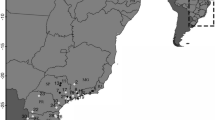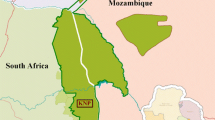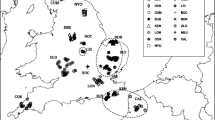Abstract
The golden jackal and red fox are among the wildlife species protected by Israeli law as enforced by the Israel Nature and Parks Authority. In 1964, as a part of a management program to control rabies in Israel, a poison eradication campaign was launched to exterminate golden jackals, considered to be the main reservoir of the disease. The program resulted in the near-complete extermination of jackals in Israel, while foxes were only mildly affected. Jackals have since regained their original numbers and have recolonized southern Israel. We here examined the population structure of the golden jackal and red fox in Israel, 48 years after the poison eradication campaign. DNA from 88 golden jackals and 89 red foxes representing five different geographic regions was extracted and amplified at 13 microsatellite loci in order to characterize the populations on a genetic level. High genetic diversity was found among the jackal and fox populations. A possible migration route through the Jordan Rift Valley was suggested for both species by the genetic similarity of populations in northern and southern Israel. However, in both species, the animals from the center of Israel were distinctive from those north or south, indicating the relative isolation of central populations, likely due to fragmentation or a high abundance of food resources. Genetic profiles obtained for the golden jackal and the red fox in Israel may aid in their conservation management and in the study of zoonotic diseases.


Similar content being viewed by others
References
Bardeleben C, Moore RL, Wayne RK (2005) A molecular phylogeny of the Canidae based on six nuclear loci. Mol Phylogenet Evol 37:815–831
Berthier K, Charbonnel N, Galan M, Chaval Y, Cosson JF (2006) Migration and recovery of the genetic diversity during the increasing density phase in cyclic vole populations. Mol Ecol 15:2665–2676
Bino G, Dolev A, Yosha D, Guter A, King R, Saltz D, Kark S (2010) Abrupt spatial and numerical responses of overabundant foxes to a reduction in anthropogenic resources. J Appl Ecol 47:1262–1271
Boom R, Sol C, Salimans M, Jansen C, Van Wertheim Dillen P, Van der Noordaa J (1990) Rapid and simple method for purification of nucleic acids. J Clin Microbiol 28:495
Central Bureau of Statistics (2010) Towns in Israel 2010. http://www1.cbs.gov.il/ishuvim/ishuvim_main.htm
Chakraborty R, Nei M (1977) Bottleneck effects on average heterozygosity and genetic distance with the stepwise mutation model. Evolution 31:347–356
Chatterji S, Pachter L (2006) Reference based annotation with GeneMapper. Genome Biol 7:R29
Chevolot M, Ellis J, Rijnsdorp A, Stam W, Olsen J (2008) Temporal changes in allele frequencies but stable genetic diversity over the past 40 years in the Irish Sea population of thornback ray, Raja clavata. Heredity 101:120–126
Chomczynski P, Sacchi N (1987) Single-step method of RNA isolation by acid guanidinium thiocyanate-phenol–chloroform extraction. Anal Biochem 162:156–159
Cornuet JM, Luikart G (1996) Description and power analysis of two tests for detecting recent population bottlenecks from allele frequency data. Genetics 144:2001–2014
David D, Dveres N, Yakobson B, Davidson I (2009) Emergence of dog rabies in the northern region of Israel. Epidemiol Infect 137:544–548
Di Rienzo A, Peterson AC, Garza JC, Valdes AM, Slatkin M, Freimer NB (1994) Mutational processes of simple-sequence repeat loci in human populations. PNAS 91:3166–3170
Dolev A (2006) Modelling the spatial dynamics of rabies in canid vectors using a realistic landscape: a tool for optimizing the spatial scattering of oral rabies vaccination. Ben-Gurion University of the Negev, Beer Sheba
Dolev A, Perevolotsky A (2004) Vertebrates in Israel: the red book. Gefen, Jerusalem
Earl DA, vonHoldt BM (2012) STRUCTURE HARVESTER: a website and program for visualizing STRUCTURE output and implementing the Evanno method. Conserv Genet Resour 4:359–361
Ellengren H, Hartman G, Johansson M, Andersson L (1993) Major histocompatibility complex monomorphism and low levers of DNA fingerprinting variability in a reintroduced and rapidly expanding population of beavers. Proc Nat Acad Sic USA 90:8150–8153
Ellstrand NC, Elam (1993) Population genetic consequences of small population size: implications for plant conservation. Annu Rev Ecol Syst 24:217–242
England PR, Osler GHR, Woodworth LM, Montgomery ME, Briscoe DA, Frankham R (2003) Effects of intense versus diffuse population bottlenecks on microsatellite genetic diversity and evolutionary potential. Conserv Genet 4:595–604
Evanno G, Regnaut S, Goudet J (2005) Detecting the number of clusters of individuals using the software structure: a simulation study. Mol Ecol 14:2611–2620
Excoffier L, Laval G, Schneider S (2005) Arlequin (version 3.0): an integrated software package for population genetics data analysis. Evol Bioinform 1:47
Frankham R (1995) Conserv Genet. Annu Rev Genet 29:305–327
Frankham R (2005) Genetics and extinction. Biol Conserv 126:131–140
Frankham R, Ralls K (1998) Conservation biology: inbreeding leads to extinction. Nature 392:441–442
Frankham R, Briscoe DA, Ballou JD (2002) Introduction to Conservation Genetics. Cambridge University Press, Cambridge
Gabbay S (1997) Conservation of biological diversity in Israel. Isr Environ Bull 20:2–10
Gutman R, Sinai Y, Sadot E, Shkedi Y (2002) The effect of traffic on Israeli roads on animal mortality, and evaluation of the efficiency of existing animal passages. Nature and Parks Authority. [In Hebrew]
Hoelzel AR, Halley J, O’Brien SJ, Campagna C, Arnborm T, Le Boeuf B, Ralls K, Dover GA (1993) J Hered 84:443–449
Hoss M, Paabo S (1993) DNA extraction from Pleistocene bones by a silica-based purification method. Nucleic Acids Res 21:3913
Jhala Y, Moehlman P (2004) Golden jackal (Canis aureus). Canids: foxes, wolves, jackals and dogs. Status survey and conservation action plan. IUCN/SSC Canid Specialist Group, Gland, Switzerland, and Cambridge, UK
Lacy RC (1997) Importance of genetic variation to the viability of mammalian populations. J Mammal 78:320–335
Lanszki J, Heltai M (2002) Feeding habits of golden jackal and red fox in south-western Hungary during winter and spring. Mamm Biol-Z Saugetierkd 67:129–136
Leberg PL (1992) Effects of population bottlenecks on genetic diversity as measured by allozyme electrophoresis. Evolution 46:477–494
Luikart G (1997) Usefulness of molecular markers for detecting population bottlenecks and monitoring genetic change. University of Montana, Missoula
Luikart G, Cornuet JM (1997) Empirical evaluation of a test for identifying recently bottlenecked populations from allele frequency data. Conserv Biol 12:228–237
Macdonald D, Reynolds J (2004) Red fox Vulpes vulpes Linnaeus, 1758, least concern (2004). Canids: foxes, wolves, jackals and dogs: status survey and conservation action plan. Gland (Switzerland): International Union for conservation of Nature Specialist Group: 129–36
Macdonald D, Voigt D (1985) The biological basis of rabies models. Population dynamics of rabies in wildlife. Academic, London
Mendelssohn H (1972) Ecological effects of chemical control of rodents and jackals in Israel. In: Favar TM, Milton JP (eds) The careless technology: ecology and International development. Natural History, New York, pp 527–544
Mendelssohn H, Yom-Tov Y (1999) Mammalia of Israel. Israel Academy of Science and Humanities, Jerusalem
Moran S, Keidar H (1993) Checklist of vertebrate damage to agriculture in Israel. Crop Prot 12:173–182
Nei M (1977) F-statistics and analysis of gene diversity in subdivided populations. Ann Hum Genet 41:225–233
Nei M, Maruyama T, Chakraborty R (1975) The bottleneck effect and genetic variability in populations. Evolution 29:1–10
Nemtzov SC (2002) Management of wildlife–human conflicts in Israel: a wide variety of vertebrate pest problems in a difficult and compact environment. In: Timm RM, Schmidt RH (eds) Proceedings of the 20th vertebrate pest conference. University of California, Davis, pp 348–353
Nemtzov S, King R (1998) Wildlife and rabies in Israel. Unpublished report of the Israel Nature and Parks Authority. [In Hebrew]
Nemtzov S, King R (2002) Management of wild canids (fox, jackal and wolf) in Israel, with respect to their damage to agriculture and to the spread of rabies. Advances in vertebrate pest management II. Filander, Furth
Peakall R, Smouse PE (2006) Genalex 6: genetic analysis in Excel. Population genetic software for teaching and research. Mol Ecol Notes 6:288–295
Piry S, Luikart G, Cornuet JM (1999) Bottleneck: a computer program for detecting recent reductions in the effective population size using allele frequency data. J Hered 90:502–503
Primmer CR, Saino N, Møller AP, Ellegren H (1998) Unravelling the processes of microsatellite evolution through analysis of germ line mutations in barn swallows Hirundo rustica. Mol Biol Evol 15:1047–1058
Pritchard JK, Stephens M, Donnelly P (2000) Inference of population structure using multilocus genotype data. Genetics 155:945–959
Roca A, Georgiadis N, O’Brien SJ (2005) Cytonuclear genomic dissociation in African elephant species. Nature 37:96–100
Shalmon B (1999) La-Teva Nolad report 1999-on the status of wild animals in Israel. The Society for the Protection of Nature in Israel, Tel-Aviv
Shmida A, Polak G (2008) The red plant book: endangered plants of Israel. Israel Nature and Parks Authority, Jerusalem
Sillero-Zubiri C, Hoffman M, Macdonald DW (2004) Canids: Foxes, Wolves, Jackals and Dogs— 2004 Status Survey and Conservation Action Plan. IUCN/SSC Canid Specialist Group ISBN 2831707862
Van Oosterhout C, Hutchinson WF, Wills DPM, Shipley P (2004) Micro-Checker: software for identifying and correcting genotyping errors in microsatellite data. Mol Ecol Notes 4:535–538
Wayne RK, Geffen E, Girman DJ, Koepfli KP, Lau LM, Marchall CR (1997) Molecular systematics of the Canidae. Syst Biol 46:622–653
White PCL, Harris S, Smith GC (1995) Fox contact behaviour and rabies spread: a model for the estimation of contact probabilities between urban foxes at different population densities and its implications for rabies control in Britain. J Appl Ecol 32:693–706
Wictum E, Kun T, Lindquist C, Malvick J, Vankan D, Sacks B (2012) Developmental validation of DogFiler, a novel multiplex for canine DNA profiling in forensic casework. Forensic Sci Int Gen (in press)
Yakobson B, Manalo D, Bader K, Perl S, Haber A, Shahimov B, Shechat N, Orgad U (1998) An epidemiological retrospective study of Rabies diagnosis and control in Israel, 1948–1997. Isr J Vet Med 53:114–127
Yom-Tov Y, Mendelssohn H (1988) Changes in the distribution and abundance of vertebrates in Israel during the 20th century. Monogr Biol 62:515–547
Zachos FE, Cirovic D, Kirschning J, Otto M, Hartl GB, Petersen B, Honnen AC (2009) Genetic variability, differentiation, and Founder effect in golden jackals (Canis aureus) from Serbia as revealed by mitochondrial DNA and nuclear microsatellite loci. Biochem Genet 47:241–250
Acknowledgments
We would like to thank all rangers of the INPA who helped in collecting the samples, Dr. M. Menotti-Raymond, Dr. A. Roca, Mr. S. Polani, and Mrs. L. Hadas for their critical reading and comments, and Mrs. H. Motro for graphical assistance. This study was supported by the Israel Nature and Parks Authority grant “The study of genetic diversity among golden jackals and red foxes populations”.
Author information
Authors and Affiliations
Corresponding author
Electronic supplementary material
Below is the link to the electronic supplementary material.
Rights and permissions
About this article
Cite this article
Magory Cohen, T., King, R., Dolev, A. et al. Genetic characterization of populations of the golden jackal and the red fox in Israel. Conserv Genet 14, 55–63 (2013). https://doi.org/10.1007/s10592-012-0423-1
Received:
Accepted:
Published:
Issue Date:
DOI: https://doi.org/10.1007/s10592-012-0423-1




